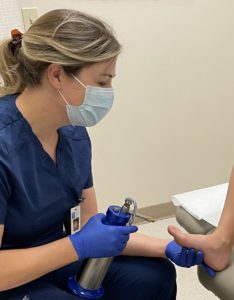Warts Treatment
At Vujevich Dermatology Associates, we provide warts treatment options including in office applications of liquid nitrogen, other topical treatments, surgical removal, and at home treatments. Warts are contagious skin growths caused by a virus in the skin. They are commonly seen in children and teens, though any age may be affected. Warts can appear on any area of the body, but they often develop on the hands, feet, or face.
Although most warts are harmless, dermatologists can treat them. Some warts do not require treatment; however, a dermatologist may treat warts that are stubborn, painful, or spreading. Warts often go away without treatment, especially for children. In adults, warts may not disappear as easily or as quickly as they do in children.
A warts treatment can take several months, and options include in-office application of liquid nitrogen, surgical removal, or at-home application of anti-viral medication and/or salicylic acid. The treatment used usually depends on the patient’s age and health as well as the type of wart. We have many treatment options for warts in our office, including cantharidin, cryotherapy, electrosurgery and curettage, and excision. If the warts are hard to treat, your dermatologist may recommend one of the following treatments: laser treatment, chemical peels, bleomycin, or immunotherapy.

If you find that the warts will not go away, are painful, or there are many of them, you can schedule a consultation with our office to discuss the warts treatment options we offer.
Learn more about warts from The American Academy of Dermatology website.
Molluscum Contagiosum
Molluscum contagiosum is a contagious bumpy rash on the skin caused by a virus. It can spread easily from person to person. Onset may occur at any age but is especially common among school-age children. The most common ways of getting molluscum contagiosum are by touching something infected with the virus such as a towel, toys, etc. or by direct skin-to-skin contact.
Usually the only sign of molluscum is pink or flesh-colored bumps that can appear anywhere on the skin. Most people get about 10 to 20 bumps on their skin, but if a person has a weakened immune system, more bumps often appear. These bumps may appear almost anywhere on the body, though most commonly in the skin folds of the underarms, back of knees, and groin. Molluscum bumps are not painful but may be itchy for some people. The good news is that the virus never affects the internal organs, rather it can only affect the skin and mucous membranes.
Molluscum contagiosum is benign and does not require treatment in mild cases. A pediatric dermatologist may treat molluscum to limit spread to other areas of the body, control itching, reduce transmission to others (ex. athletes in contact sports), and minimize potential for scarring. We’re proud to have one of the few pediatric dermatologists in the local area on our team, Dr. Elizabeth J. Froelich. Dr. Froelich is a board-certified dermatologist and board-certified pediatric dermatologist by the American Board of Dermatology.
Treatment options include in-office application of liquid nitrogen or cantharidin, surgical removal, or at-home application of anti-viral creams. If you believe your child has molluscum contagiosum, you can schedule a consultation with our office for an accurate diagnosis and proper treatment plan.
Learn more about molluscum contagiosum from The American Academy of Dermatology website.
